Scotland
It's always nice to get into a city early, that way you have the whole day to explore, getting in at 6am isn't so great. After waiting for Hertz to open at the airport, we pick up our rental car, a nice little Ford Focus. We plug in 'Austin' (our TomTom GPS affectionately named after Austin Powers, the voice I downloaded for the unit), and head to the only hotel I booked on this trip.
Hopefully they got the message that we weren't going to be arriving on the day we expected.
Glasgow
We find a spot on the street and walk into McClay's Guest House, the reception tells us we can't get into a room until 1pm, but they can keep our bags, and we are welcome to go and enjoy breakfast in their breakfast room. "A full Scottish breakfast" consisting of egg, bacon, sausage, tomato, mushrooms and baked beans... on the house... ok, vacation starts now.
 It's always a good idea to have your first nights hotel booked before you arrive, after a long flight you don't want to be looking for somewhere to stay, and the customs/immigration officer where you land will often want to know the address where you are staying.
It's always a good idea to have your first nights hotel booked before you arrive, after a long flight you don't want to be looking for somewhere to stay, and the customs/immigration officer where you land will often want to know the address where you are staying.
When we head back to the car to find a legal parking spot, and bring our bags in, we discover that the Remote key doesn't work, and proceed to set off the car alarm twice. At 8am on a Sunday morning we are probably the most popular people in Scotland. Luckily someone pulls out of a spot just as we get the bags out, and I back into the spot, park, and set off the alarm again.
Glasgow definitely has an industrial city feel to it, it's a bit run down, but still has some interesting sights. Glasgow Cathedral, originally consecrated in 1197, sits next to the Necropolis Cemetery. A church and a cemetery will be a common sight when touring this part of the world, but the details when you look closer are what make Glasgow more interesting.
The door knocker on the front of the cathedral is not what you would expect. The mixture of tombs, grave markers, crosses and monuments in the hillside location of the Necropolis hide interesting historical figures such as William Miller, the Author of 'Wee Willie Winkie'.
As we leave the gothic area of Glasgow and head into the city center, we pass a couple unique locations... the first is the Old College Bar, listed as Glasgow's oldest public house (circa 1515), it smells like a lot of beer has been spilled over the last 500 years. The second unique location is the Tollbooth clock tower, a 17th century clocktower left to stand in the middle of the street after the remainder of the tollbooth building was demolished.
Wandering into the historic George Square, named after King George III, I notice that historic figures are not given much respect by the local birds. It's no wonder they look grumpy.
The square is surrounded by historic buildings, most notably the impressive Glasgow City chambers and the post office. As the weather changes from heavy rain to clouds to blue sky, we adapt. as we go... layering, jacket on, jacket off, rain poncho on, rain poncho off.
We wander the town for hours and then back-track a bit and head to the People's Palace, we're not sure what it is, and are pleasantly surprised to see the impressive building and its more impressive Doulton Fountain. Each side of the fountain depicts a British colony, Canada's side is interesting.
After an entire day of wandering the streets of Glasgow we are exhausted, and head back to McLay's guest house to check-in and have a brief nap (perhaps pass-out is a better description).
It seems there is only one way to immerse ourselves in this culture, so we go see the latest Harry Potter movie at Cineworld. It is the largest theater I have ever seen in my life, the movie was good, and made more exciting when a fight breaks out in the theater once it is over.
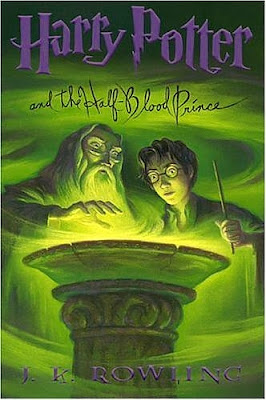
A long day of travel and exploration would end up as a very interesting first day in Scotland.
After our first night of sleep in the industrial city of Glasgow, it is time to get out of the city and head into the Scottish Highlands and the true countryside of this country.
It doesn't take long to get away from the cities in Scotland, we stop for a break in the small town of Luss on Loch Lomond. Getting out of our car the wildlife is abundant, bunnies and birds. Luss is a cute little resort town, small cottages on a nice lake... too bad it's so cloudy.
Heading north we start to see more of the local wildlife, sheep and the famously cute Scottish Cattle. The Sheep are everywhere, in fields and on the roadsides. The cattle watch as we go by.
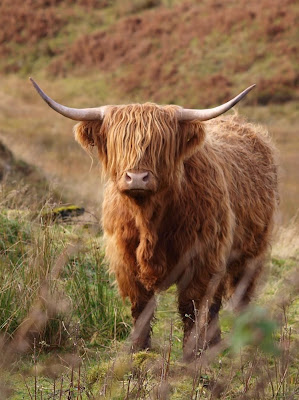
Our next stop is Inveraray Castle, the home of the Duke of Argyll. With the rain coming down it is nice to head inside and explore this Baroque/Gothic castle built in 1746.
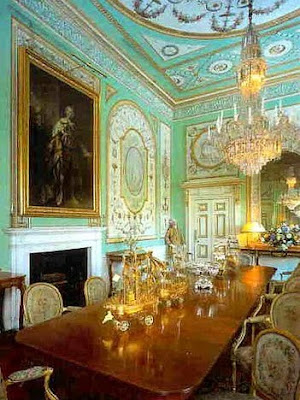
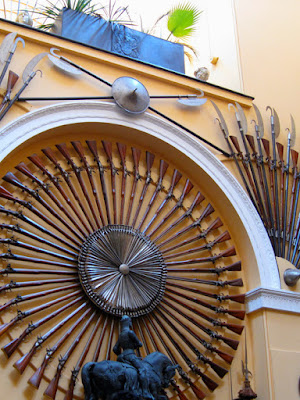
Continuing North we spot Kilchurn Castle from the road, and stop to check it out. The rain has stopped for a bit, but the path to the castle is very swampy, and we turn back before we lose a shoe in the mud. Kilchurn Castle was built by the Campbell clan on Loch Awe way back in 1450.
Across Loch Awe sits a gorgeous mansion, we couldn't learn any more about this awesome house.
 Having a GPS unit is a god-send in a country with so many roads and poor direction signs,
Having a GPS unit is a god-send in a country with so many roads and poor direction signs,
if there is a sign, there's no warning to turnoff. A GPS gets you to where you need to go, knows where you are, and usually has a good idea when you are going to get there.
For better or worse when determining routes our GPS looks for the fastest most direct route, even if that means going down a very narrow windy road, 'Austin' sends us on 20km of narrow windy roads as we continue North. We get a true feel of Scotland as we pull tight against hedges to allow oncoming traffic get by, and both close our eyes as huge trucks squeeze past us.
One of the benefits of the smaller roads is the amazing scenery you don't normally see speeding down a highway at 70 MPH. Craigwater waterfall is one of those sights, mixed amongst sheep fields and the mountains are creeks, rivers, and rustic cabins.
The Glencoe region of Scotland is filled with Majestic mountains and Lochs (lakes), much like B.C.

Our next stop is at the 13th century ruins of Inverlochy Castle near Fort William, the location of many historic battles before Robert the Bruce defeated the Comyn's who built the Castle.
As we wind our way along the narrow mountainous roads we are slowed down by a bad accident, 4 guys are standing beside their car, which is teetering off the side of the road, a few feet from a steep drop off. The smashed up side of the car seems to indicate they got too close to oncoming traffic. Or they were busy admiring Loch Linnhe, a scenic lake in a valley below the road.
One of our last stops of the day is the iconic Eilean Donan Castle, with a history dating back to the 6th century, the latest iteration of this 13th century castle has been seen in almost every movie that takes place in Scotland. Highlander, James Bond, Entrapment and even Made of Honor.
Sadly we arrived about 10 minutes too late, and the castle is closed, we'll have to come back when we leave the Isle of Skye. Skye bridge opened in 1995 and connects the mainland with the Isle of Skye and replaced a ferry service that ran from 1600. After a backlash on the tolls, it is now free.
Isle of Skye
After crossing the bridge we head into the small town of Kyleakin and accidentally follow a car right into a B&B parking lot. Turns out it's the owner, may as well see if he has a room. He does, and the room in the waterfront Cliffe House has three amazing views of the harbour... score!
Since the rains had stopped for a while, and it stays light until past 9:00 we decided to hike to Castle Moil, the ruins were just around Kyleakin Harbour. When we cross a low spot and see the stone with it's ominous message of "Beware the Tides", it's an easy choice to turn around as the path changes from a nice trail to a muddy swamp. Better to be safe than camp overnight.
Our decision to turn around was a good one as it started to rain again, and we escaped the weather at one of the few restaurants that was open. One restaurant showed signs that it was only open on Wednesdays, but was closed for the next 2 Wednesdays... WTF?
After a scrumptious seafood dinner the rains stopped again, long enough to climb up to the Celtic cross monument and viewpoint, and watched the sun set on Castle Moil.
After a full Scottish breakfast with 4 ladies from Italy we head out to tour the Isle of Skye.
First stop is Dun Beag Broch, a hillside ring fort estimated to date back to 100 BC.
Our next stop Dunvegan Castle, is the oldest continuously inhabited castle in Scotland and has been the stronghold of the chiefs of the MacLeod clan for nearly 800 years. The view over the bay is impressive, and it's natural gardens make for a nice day when it's not raining.
In the town of Colbost we get a closer look at the locals snoozing in the grass, and more traditional thatch roof houses. Sheep become more and more common the further we go.
The closer we get to Neist Point, the more sheep we see, the narrower and windier the roads get. By the time we are a few miles away, it's a single lane road with small pullouts for passing oncoming traffic. Sheep are no longer staying in the fields and are all over the roads.
 When renting a car in the British Isles it is highly recommended that you get a car as small as possible that can fit all your luggage. The roads are very narrow, and you need to be able to pass or let other bigger vehicles past you... luxury vs loss of a mirror, your choice.
When renting a car in the British Isles it is highly recommended that you get a car as small as possible that can fit all your luggage. The roads are very narrow, and you need to be able to pass or let other bigger vehicles past you... luxury vs loss of a mirror, your choice.
After finally getting to Neist Point safely, we are at the most westerly point of the Isle of Skye looking out at the Uist Islands and the Atlantic Ocean.
it's a long steep climb to the lighthouse, but the views are worth it.
Completing our circle of the Isle of Skye, we cross Skye bridge and visit Eilean Donan Castle again.
Our next stop is the most famous of locations in Scotland, Loch Ness. Home to the infamous Loch Ness Monster aka Nessie. A legend since being photographed in 1933.
I saw this image of Nessie below Urquhart Castle when I was a kid. The Scots believe strongly in a 9-5 workday, and we arrive a few minutes late to be able to explore Urquhart Castle. That's ok, we'll just take a picture over the wall and go to the Loch Ness Museum, doh! It's closed too.
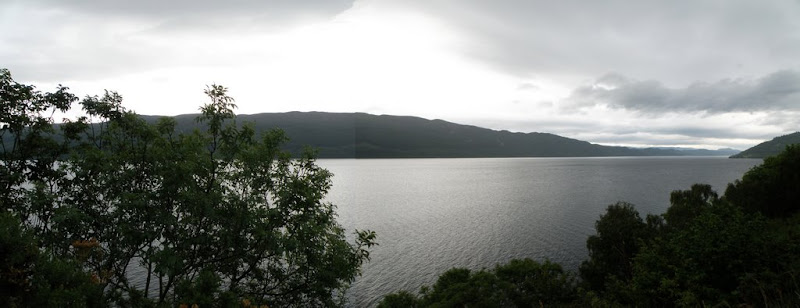
The infamous Loch Ness
As we roll into Inverness in the pouring rain we decide to rough it, and splurge on a Ramada hotel. It's a brand new hotel, 105 £ for the night. The internet didn't work, phone didn't work, the smoke detector chirped, TV acted up, and it didn't even include breakfast. Nice splurge.
Inverness
In the morning we walk along the River Ness, checking out some of the churches, and wander up to Inverness Castle which is now a sheriff's court building. Castles have been on this hill since the 11th century, this impressive red sandstone castle was built in 1836.
A nice surprise awaits us as we head back to the car to continue our journey, a parking ticket. Apparently when I closed the door, the parking slip flipped over on the dash. The Ticket says "unable to read parking slip"... Time to get out of Inverness.
On the way to our next stop we see a sign for Kilravock Castle and decide to check it out. It's a short detour down a long single lane road, only to discover it's a B&B.
The roads through Scotland become more interesting when you add in these steep single lane bridges, luckily this one had a light, usually it's first to the peak has right of way, they are steep enough you can't see oncoming vehicles, forcing you to back up if you're not first.
Our next stop is the impressive Cawdor Castle & Gardens, dating back to the 14th century, and tied to Shakespeare's Macbeth via three witches. The Cawdor family still lives in the castle to this day. The grounds are massive, even including their own golf course.

Traveling through the Scottish countryside, you can't help but take in a wide variety of scenery, surprises pop up as we pass the impressive train bridge from Harry Potter and other movies, or you see abandoned castles left to crumble on the side of the road.
Just outside of Perth is the massive Scone Palace, the original home of the Stone of Scone aka the Stone of Destiny. It was the crowning place of the Kings of Scots, including Macbeth in 1040, and Robert the Bruce in 1306, the red sandstone palace is now owned by the 8th Earl of Mansfield.
Working our way towards Edinburgh, we stop in St. Andrews, most famous for its golf course, it's a big university town, with several historic ruins that mark the center of the town.
St Andrews Cathedral was founded in 1158, and fell into disuse during the reformation period in the 1500's. We wander around the ruins imagining how impressive it must have been in it's day.

St. Andrews Castle has stood on the cliffside of the North Sea since the 12th century, and has been left in it's ruined state since the 17th century.
St Salvator's College was founded in 1450 and remains a historic center of the college town. Perhaps a college prank resulted in the naming of some of their streets?
 Whenever traveling somewhere new, I always like to talk to friends or other people that have traveled there before. You never know what little tid-bit of info, or must see destination may come up in the conversation that you may never have known about. Information like the hotel that is right at city center with amazing views of a castle.
Whenever traveling somewhere new, I always like to talk to friends or other people that have traveled there before. You never know what little tid-bit of info, or must see destination may come up in the conversation that you may never have known about. Information like the hotel that is right at city center with amazing views of a castle.
Edinburgh
Arriving in Edinburgh was made a lot more challenging due to the entire main road closed with construction for a new transit system. The same main road our hotel was on, Austin had a bit of trouble getting us there, until we finally parked on a closed street and walked to the Old Waverly hotel. Norine checked in, and I had to find a parkade and returned to find a very nice hotel room with an amazing view of the old city and Edinburgh Castle. That was worth the troubles.
The amazing view from our room
As it was late in the day we walked around some of the immediate area, just as the rains picked up again, and went back to our hotel for dinner. The service was terrible, we never did get the drinks we ordered, and the waiter would disappear for long periods of time. It took almost 2 hours for dinner, but at least the food was great, and we just saved some money on tips.
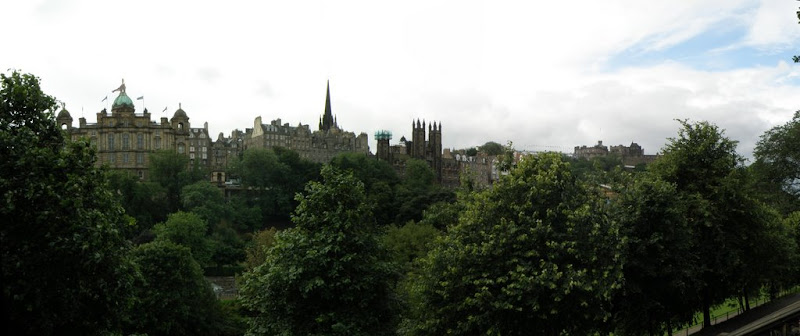
After another Scottish breakfast we head towards Edinburgh Castle, past Scottish panhandlers and the Sir Walter Scott monument, through Princes St Gardens and up castle hill.
It's a steep hike, but the views are worth it, looking back down on the city, and up to the Castle.
There has been a royal castle on this hilltop of Edinburgh since the 12th century. With a mix of structures, military, religious and historic, we spend the better part of the morning exploring.
From crazy unicorn mascots to traditional bagpipers, we cover the massive grounds before going into David's tower and then finally into the royal palace.
The Scottish crown jewels and the Stone of Destiny are highlights of the palace tour. The Stone of Destiny aka Stone of Scone was a block of sandstone that was used at the coronation of the kings and queens of Scotland for centuries before being taken by Britain, and finally returned in 1996.
Easily missed as you start the trek down the Royal Mile is the Witches well. A cast iron wall fountain commemorates the place where over three hundred women were burned at the stake accused of being witches. In the 16th Century more witch burnings were carried out at Castlehill than anywhere else in the country. The victims often suffered brutal torture before being put to death at the stake, or drowned to ensure they weren't witches. If they survived they were witches, if they didn't then they went to heaven with a cleansed soul.
The stretch of roads that run from the Castle to Holyrood Palace is know as the Royal Mile. It's an interesting mix of tourist spots, pubs and historic buildings. Even Braveheart is here!
For lunch we had to go to Deacon Brodies Tavern, in a historic 1703 building.
Deacon William Brodie was a very respectable citizen of Edinburgh, by day a cabinet maker, the top of his profession. But he had some bad habits: He used to drink, and gamble and he had two mistresses. This life style took quite a lot of his money. So by night he used to rob the houses and businesses in the area. It was not hard for him to find the opportunity: As a cabinet maker he would often go to people's houses to measure up in order to make a cabinet. He would wait until their attention was distracted and would make an impression of the keys in a piece of putty.
Late night robberies became common place in the old town of Edinburgh and of course no one suspected the respectable Deacon. However Deacon Brodie was recognized at a robbery and fled from the scene, but he was eventually caught and sentenced to hang. Ironically the very gallows that he had designed had sealed his fate. Deacon Brodie's double life of good and evil was the inspiration for Robert Louis Stevenson's work "The strange case of Dr. Jekyll and Mr. Hyde".
Along the Royal Mile is a collection of historic churches, what you think is going to be filled with stained glass windows, pews and altars, turns out to be The Hub... the tourist information center.
At the midpoint of the Royal Mile is the most impressive of the churches; the St Giles Cathedral, with a long history dating back to 1120 AD. The steeple stands out on the Edinburgh skyline.
As we near the end of the Royal Mile, the Tollbooth Tavern and Wynd (Narrow path) remind us of the long history that this area has. Our hotel in Edinburgh is older than our country.
The Palace of Holyroodhouse is the official residence of the Monarch of the United Kingdom in Scotland. Even today the Queen visits once a year, although we are told that she doesn't stay as long anymore since she is getting elderly now. It was founded as a monastery in 1128, and became the official residence of the Kings and Queens of Scots since the 15th century.
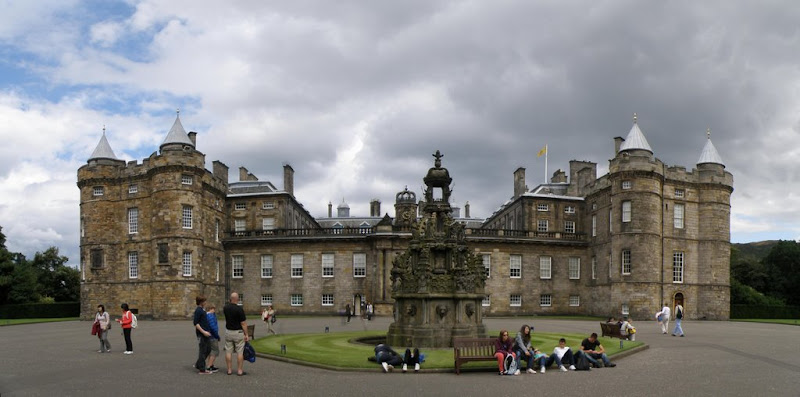
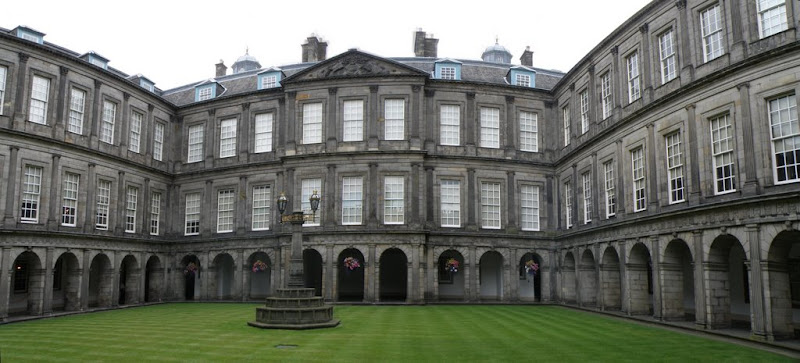
We wander the grounds of Holyrood Abbey, a ruined Augustinian Abbey on the grounds of Holyroodhouse. Finally we visit the Queens gallery, it was opened in 2002 by Queen Elizabeth II, and exhibits works from the Royal Collection. It contains some beautiful artwork and the limited size of the collection leaves us time to explore more of Edinburgh.
Calton Hill to the east of Edinburgh's New Town, provides a scenic backdrop to the city, with it's impressive monuments and amazing views over the city and of Castle Hill.
The National Monument was intended to be a full replica of the Parthenon, but money ran out midway through construction and only one side of the structure was completed. Across the way is Arthur's Seat a group of hills overlooking the city and forming Holyrood park.
We head back down into the New Town area of Edinburgh for the last part of our exploration of the city and check out the Neo-classical building that houses the National Gallery of Scotland, and eventually find a 1796 Georgian style house that was the basis for rebuilding this part of the city.
An amazing dinner at the Bella Italia restaurant would wrap up our stay in Edinburgh,
sadly, tomorrow would be our last day in Scotland.
It's raining as we leave, our last stop would be Stirling Castle, the Castle dates back to the 12th century, it became one of the key strategic fortifications from the 14th - 16th centuries. Several Kings and Queens have been crowned here, including Mary, Queen of Scots, in 1543.
On a hill overlooked by the Robert of Bruce statue is the Wallace Monument, a tribute to the legendary William Wallace made famous by his campaign of Scottish freedom against King Edward I in 1297, his story was brought to life by the movie Braveheart starring Mel Gibson.
Since the Stirling Castle Palace was closed, it didn't take long to explore the castle, so we lowered our umbrellas and got back in the car to head for the Scottish/English border.


